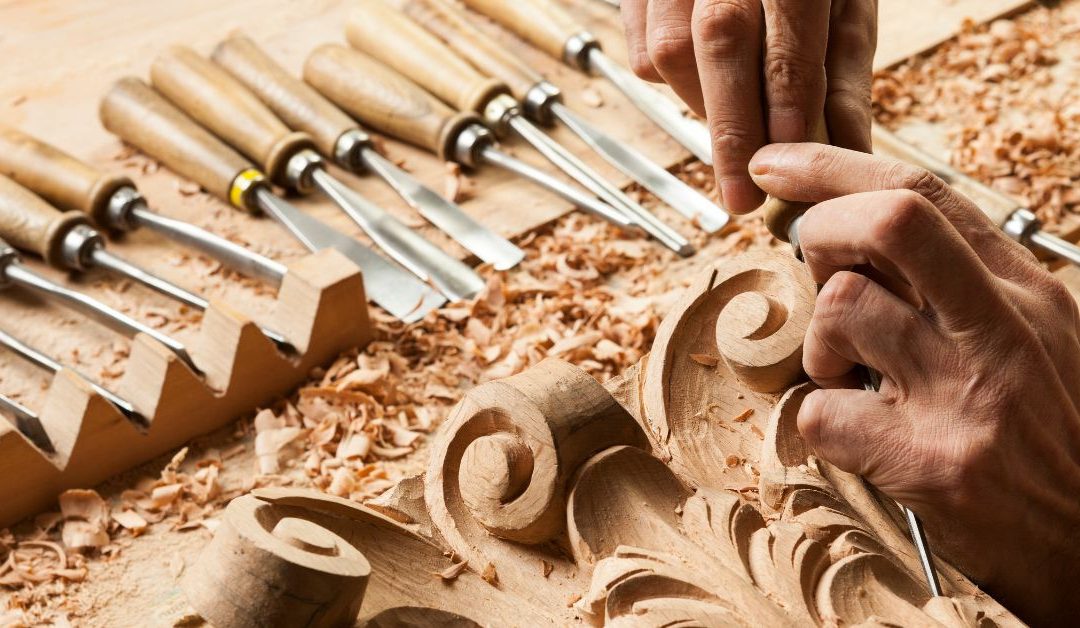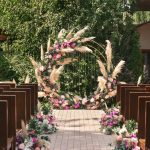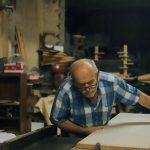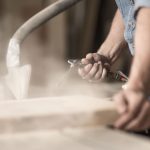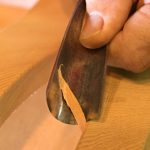Morocco is a country with different landscapes and cultures. People in Morocco have been making beautiful things out of wood for a very long time. They use their skills and the things they find in nature to create special designs.
I am an expert in this field, and I have learned a lot about different styles of Moroccan woodworking. I have seen pieces that have small pieces of wood put together like a puzzle and others that have bright colors painted on them.
In this article, I want to tell you about what I’ve learned from skilled artisans who make these amazing things. They will show us how they create these special pieces and what we can learn about Morocco’s culture and history by looking at them.
The Origins Of Moroccan Woodworking
People in Morocco have been practicing woodworking for a very long time, and it shows how diverse the country is. The craftsmen use safe methods to make special things from different types of wood. You can find this craft all over Morocco, from small villages to big cities.
Different cultures influence the woodwork in Morocco. For example, the Berber people in the mountains and the dynasties that ruled long ago have their techniques. Families have passed down these techniques for many years.
Whether it’s delicate patterns or handmade furniture, every piece has a story that tells us where it comes from. This shows how Moroccans value their traditions and also embrace new ideas.
With this in mind, let us take a look at the types of woods used in Moroccan crafts.
Types Of Woods Used In Moroccan Crafts

I love how Morocco’s woodworking reflects the diversity of its geographical landscape.
From cedar to olive, palm to acacia, and even ironwood and cypress, there’s something for every type of craft.
Morocco has many different types of wood that woodworkers love to use. Some of these woods have fancy names like thuya, juniper, ebony, boxwood, rosewood, cedar of Lebanon, walnut, thuja, and tamarisk. It’s like a dream come true for woodworkers!
Every wood has its unique look and feels, making Moroccan woodworking a special craft.
Cedar
Moroccan craftsmen love to use cedar wood because it is strong and lasts a long time. They can find cedar trees in different parts of Morocco, like the mountains and plains. It’s important to take care when cutting down cedar trees so that there will be enough for the future. Craftsmen can continue to use cedar for a long time with good care. Cedar is special because it represents the different places in Morocco and inspires craftsmen for their work.
Olive
Olive wood is another wood type used in Moroccan crafts. Its unique grain and color make cedar a great choice for craftsmen who need to carve intricate designs or patterns into their items.
Like cedar, it’s important to harvest olive trees with care so that future generations can enjoy them too! Craftsmen can use olive oil, which comes from olives, to dye wood and add beautiful colors to their crafts. The oil finishes on olive wood make the finished products even more attractive when displayed. With careful care and management, olive trees will continue to be a source of joy for Moroccan craftsmen in the future.
Palm
Craftsmen in Morocco use palm wood, which comes from palm trees, for their crafts. Palmwood has a unique color that ranges from white to yellow-brown. It is lightweight, making it easier for craftsmen to work with when creating intricate designs. Craftsmen in Morocco should harvest palm trees with care to ensure that future generations can use this resource.
Craftsmen can use the oil extracted from the fruit of palm wood as an advantage to dye fabrics and create different finishes. With careful management, palm trees will continue to provide an abundant supply of material for craftsmen in Morocco. Crafters choose palm wood for their projects because it is lightweight and durable, and they can color it with dyes.
The Symbolic Meaning Of Moroccan Woodwork
Moroccan woodworking is special because it reflects the culture and has symbolic tools. The tools used in Moroccan woodworking have special stories and meanings. For example, rulers represent far distances between towns, and shovels represent farming. Even small tools like hammers and awls convey special meanings, showcasing the skill and talent of the craftsmen. The diversity of these tools shows how the culture embraces differences and works towards common goals.
Regional Variations In Moroccan Woodworking
Moroccan woodworking is a special way of making things out of wood in Morocco. It shows the different places and environments in the country. Families have passed down meanings in woodworking for a long time. It’s like a special language that tells stories and represents the culture and history of Morocco.
In each region of Morocco, people’s culture and the weather affect how they use and work with wood. For example, in central Morocco, artisans make detailed designs with exotic woods. In the north, where the weather is tough, they make furniture that can withstand it.
In different parts of Morocco, people use wood in different ways. In the southeast, they carve deep patterns with shapes like squares and triangles. In the north, they use special techniques from other cultures to make cabinets and chests.
So, depending on where you are in Morocco, woodworkers have their unique styles. They create beautiful designs using special skills they learned from different cultures. It’s like having different recipes for cooking depending on where you live!
All these different ways of working with wood make special things that show the culture of each place. Moroccan woodworkers have special tools and ways to make furniture and pretty things like boxes and trays that are useful and look nice.
Moroccan woodworkers have been making beautiful wooden things for a very long time. By understanding what inspires them and the place they live, we can see how important their work is to their culture and others.
Learning about the special tools and techniques they use in Moroccan woodworking will help us know and like this amazing craft even more.
Traditional Tools And Techniques
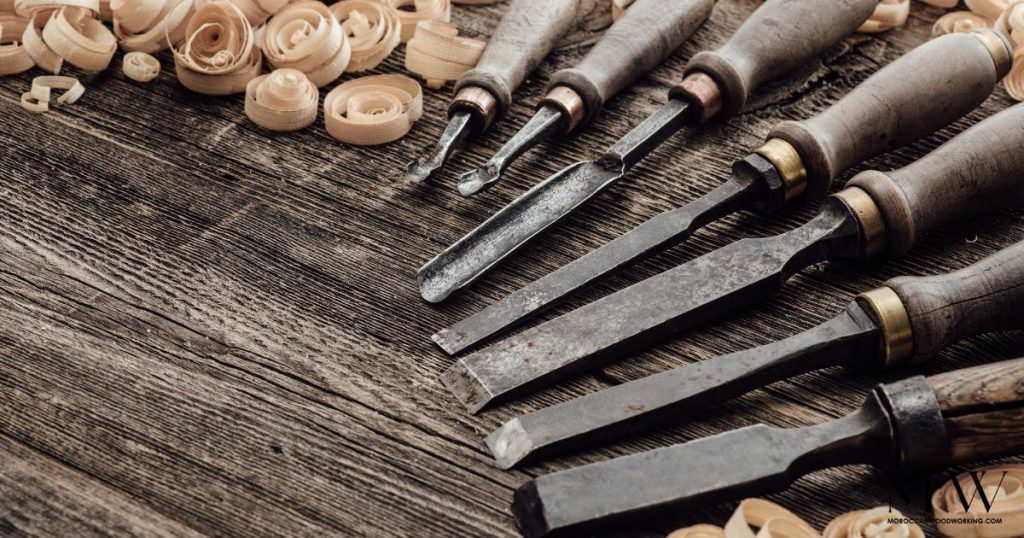
Woodworking in Morocco is like a beautiful mix of different cultures. Craftsmen have passed down the methods for many generations, keeping the craft alive and vibrant. They use different types of wood, like cedar and olive, which grow in different parts of the country.
To prepare the wood, craftsmen dry it in different ways depending on the type and how they will use it. The craftsmen use special tools like saws, chisels, and planes, which they make by hand using metal or stone-cutting tools.
These craftsmen are very skilled and admired by people all over the world. They have learned from many generations before them and continue to pass on their knowledge. They make beautiful furniture and sculptures using Morocco’s natural resources.
So, Moroccan woodworking is a combination of tradition, culture, and skill that creates stunning pieces of art.
Intricate Marquetry
Craftsmen in Morocco are great for their expertise in a special kind of art called marquetry. It’s all about making very detailed and fancy patterns using different pieces of wood. It takes a lot of skill and careful work to make these patterns look beautiful. People from all over the world like this kind of art because it’s so impressive and well-made.
Craftsmen have been practicing this technique for centuries, and it has become a part of Morocco’s cultural heritage.
To make marquetry, craftsmen cut different shapes from wood veneer and arrange them to form a precise image or design.
The artwork in marquetry made it great worldwide for its vibrant colors, impressive detail, and perfect symmetry.
Artisans use tools like saws and scalpels to cut out the pieces with great accuracy.
Marquetry is a special kind of art in Moroccan woodworking. It takes a long time to create only one piece, but the final result is a beautiful work of art that shows Morocco’s culture. People love it and use it as fancy decorations or special family treasures. Marquetry is like a picture that tells stories about Morocco’s history and geography. It’s so impressive that it leaves a lasting impression on everyone who sees it, no matter where they’re from.
To explore even more ways in which Morocco expresses itself artistically, let us turn now to colorful painted panels …
Colorful Painted Panels
In Morocco, there is a special art called marquetry. People have been using marquetry for a long time to decorate wooden furniture with fancy designs. It’s an amazing craft!
Another interesting thing in Morocco is the colorful paintings on wooden panels found in traditional homes. They use bright shades of blue, green, and yellow that stand out against the wood.
The painters do a special technique called layering. They paint dark colors first, then add lighter colors on top. This makes the design look more detailed and gives it a 3D effect. Sometimes they even add gold or shiny glazes to make it extra fancy.
These colorful paintings are as beautiful as the marquetry. They add another kind of decoration to Moroccan woodworking.
Now let’s talk about other decorations like inlaid woodwork and carving in Morocco.
Inlaid Woodwork And Carving
Moroccan woodworking is a special craft. It uses different techniques to make beautiful designs on wood furniture and decorations. Inlay work and carving are important parts of this craft.
In inlay work, craftsmen create detailed patterns using different types of wood like cedar, olive, cherry, or pine. They can also use materials like plastic or metal for colorful designs. Carving is another way to decorate wood by cutting away material to make pictures or symbols inspired by Islamic culture. These carvings give trays, chests, and chairs a unique look.
Moroccan woodworkers are famous for their creativity and skill. They keep traditional techniques alive while trying new materials and tools to make their work even more beautiful. Many artists now use Moroccan woodworking in their projects.
In Morocco, people who are good at woodworking can make cool stuff. They can carve sculptures that show things we see in our everyday life, like people or objects. They can also make little mosques that have pretty designs on them. It’s like making art out of wood! It takes practice and patience to become skilled in this craft. Each piece needs careful attention to detail and time to make it perfect.
Moroccan woodworkers make various items like engraved jewelry boxes and custom-made decorative platters. Craftsmen make each item with care and precision. In different parts of Morocco, people have different ways of making things out of wood. They use materials from their local area and sometimes from other places to create special and one-of-a-kind products.
Thus, Moroccan woodworking is a special art form that shows the talent and creativity of the craftsmen. It requires hard work and dedication to make beautiful and unique pieces.
Popular Items Produced Through Moroccan Woodworking
Moroccan woodworking is well-known for creating special furniture like tables and armoires. What makes them special is that talented woodworkers make detailed designs on them, creating special patterns in the wood. They also make carvings that show scenes and patterns from Morocco. Another cool thing they make is musical instruments like lutes, ouds, and sazs. Craftsmen make these items with great skill and attention to detail, using the diverse landscapes and cultures of Morocco.
Crafting these items is a labor of love, and it shows in the final product.
There’s nothing quite like the feeling of owning a piece of Moroccan woodworking!
Furniture
Moroccan woodworking has been an integral part of the country’s culture for centuries.
Moroccan woodworkers are good at making furniture. They use special tools to carve and decorate the wood, and they also add cool materials to make it look even more special. People like the furniture they make because it’s unique and well-crafted. They can create both old-fashioned and modern furniture using machines. These skilled craftsmen also restore old furniture to make it look nice again. Handmade pieces by talented woodworkers are valuable and special. People all over the world appreciate the long history of Moroccan woodworking.
Carvings
In Moroccan woodworking, carving is important. The craftsmen use special tools to make fancy designs on furniture and other things. They use wood that’s harvested in a sustainable way to protect the forests. They also use techniques like waxing or lacquering to keep the carvings looking good over time. The carvings make the pieces special and unique. Skilled Moroccan artisans make sure each carving is perfect and beautiful.
Musical Instruments
Moroccan woodworking is famous for making high-quality musical instruments. The artisans use special techniques to create beautiful instruments that produce beautiful music. They choose with care the type of wood that will give the best sound. They shape and file the wood to make it smooth and precise. This ensures that the instruments will last a long time and sound great. Whether it’s a lute, drum, or another stringed instrument, there are many options for making and enjoying music in Morocco.
Some people might think that the designs in Moroccan woodworking look old-fashioned. But skilled craftsmen make these designs in a special way, getting ideas from different cultures and traditions. To see how great the work is, we need to understand and appreciate the special techniques used by the craftsmen in Morocco. They are very skilled in making wooden furniture and decorations that are unique and beautiful. So, even though they may seem old, they are very special and show how talented the craftsmen are.
Moroccan artisans make beautiful furniture and decorations using different skills and materials. They carve fancy patterns on trunks and chests and paint designs on furnishings. These designs are timeless and show the different landscapes in Morocco. The artisans use local materials like cedarwood and walnut, which make their work even more special.
They use their knowledge and skills to create great pieces that represent Moroccan culture and are visible in modern homes. Some furniture has cool patterns inspired by Islamic buildings, which give a unique and interesting touch to any room.
Interior designers like the special and unique pieces that Moroccan woodworkers create. They make modern cabinets using old wood, which gives the cabinets a lot of character.
Contemporary Moroccan woodworking has something special for everyone. They make one-of-a-kind creations that are colorful, have different textures, and are full of imagination.
Frequent-Asked Questions
What Are The Health And Safety Regulations For Working With Wood In Morocco?
When you work with wood in Morocco, it’s important to know the right way to do it and stay safe. As an expert in Moroccan woodworking, I can give you some tips.
First, protect yourself by wearing gloves and safety glasses to avoid getting hurt by wood splinters or dust.
Next, make sure your tools are sharp and taken care of. Dull tools can be dangerous and cause accidents.
Thus, follow the rules and regulations about using power tools and collecting sawdust. It’s important to be responsible and keep the environment clean.
By following these tips, you can have a fun and safe time creating amazing things with wood in Morocco!
How Is The Cost Of Moroccan Woodworking Compared To Other Countries?
When it comes to the cost of Moroccan woodworking, it is usually less expensive compared to other countries. This is because of the cultural influences and the many natural resources found in Morocco.
The traditional methods used in Moroccan woodworking need a lot of skill and hard work from experienced craftsmen. They know how to use the different landscapes in Morocco to make their creations special.
Moroccan woodworking is cheaper compared to other countries, but talented craftsmen put a lot of effort into their work.
What Are The Most Common Types Of Wood Used In Moroccan Woodworking?
In Moroccan woodworking, craftsmen use different types of wood to make beautiful things. They choose special woods like cedar, ebony, rosewood, thuya burl, and olive tree wood. These woods are strong and long-lasting. With these woods, Moroccan woodworkers can create special and unique pieces that show the different places in Morocco.
Are There Any Moroccan Woodworking Apprenticeship Programs Available?
Moroccan woodworking has been around for a very long time, and it involves using special techniques. If you want to learn this craft, you can join apprenticeship programs where you can work with experienced craftsmen. This helps you gain hands-on experience and learn about the different types of wood used in Moroccan woodworking. It’s a great way to understand the unique places in Morocco and create beautiful pieces with detailed designs.
How Do Moroccan Woodworkers Source Their Raw Materials?
Woodworkers in Morocco have a special way of getting the wood they need. They visit different villages in the country to find the best wood for their work. They look for things like cedar and sandalwood and make sure they get them in a sustainable and fair way. This makes them feel proud because they are taking care of the environment while creating beautiful things with wood.
Moroccan woodworking is a special art form that creates amazing things. The woodworkers pay a lot of attention to detail and make beautiful and well-crafted pieces. It is a part of Moroccan culture and they follow rules to keep themselves safe. I have seen their work and it is incredible. I am proud to work with them and see the fantastic projects they create.

